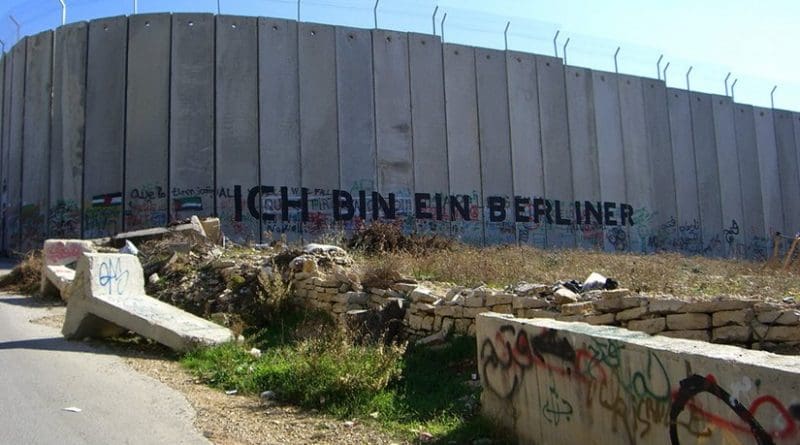Palestinians Should Refocus Attention On Illegal West Bank Wall – OpEd
By Ray Hanania
Israel’s 700-kilometer West Bank wall, which separates Palestinians from much of their land, has many names. Often called “the fence” by supporters to water down its impact and “the apartheid wall” by critics to emphasize its racist intended goals, the wall demonstrates the powerful point that Israel can thumb its nose at the international rule of law without consequence.
To avoid taking sides, many media outlets have embraced the vanilla description of the wall as “the barrier,” which only undermines the gross atrocities of its human rights violations. The apartheid wall’s construction began in 2002, but was denouncedin a legal ruling issued 15 years ago — on July 9, 2004 — by the International Court of Justice (ICJ).
Although the 71-page ruling concluded that the wall is “contrary to international law” and should be torn down, Israel has instead come to rely on it to not only separate it from the Palestinians whose land it occupies, but also to use it to absorb additional West Bank lands that hold the area’s water wells. Its 700 kilometers is double the length of the Green Line — the border that separated Israel, Gaza and the West Bank until the 1967 Arab-Israeli War allowed Tel Aviv to absorb the remaining Palestinian areas.
Rather than being built on the Green Line, the majority of the wallis built inside the Occupied Territories, allowing Israel to absorb large areas of West Bank land and separate Palestinians from their properties. Palestinians have rightfully accused Israel’s government of using the wall as another means of annexing occupied lands in contravention of international laws.
The ICJ concluded Israel must make reparations for the legal violations Palestinians have suffered. It called on the world’s nations not to recognize the wall, noting it violated the Fourth Geneva Convention, and urged the UN to take whatever action it can to reverse the wall’s construction.
Yet, despite the ICJ ruling, the wall still stands and has been quietly pushed aside as a substantive issue by advancing political dramas that continue to grow, including: Israeli violence against civilian protesters along the border with the Gaza Strip; the escalation in property annexations; the increased effort to silence critics of Israeli policies; and the banning of Palestinian activists from entering the West Bank.
Despite the ICJ’s powerful ruling, no major effort has been taken to challenge the wall’s legality in a court of law. And worse, despite some ongoing protestslike those by villagers at Bil’in, the issue of the wall has become silent and inconsequential. That fact alone reflects the failure of Palestinian resistance over the years.
The wall has been absorbed into the daily lives of Palestinians and Israelis. On the Israeli side are beautifully painted murals reflecting positive themes that counter the daily news coverage of violence by Israeli soldiers against Palestinian civilians. On the Palestinian side, the wall has been covered with graffiti and paintings reflecting a spirit of struggle that seems greater than the reality. One of the most famous paintings protesting the occupation was by Banksy, yet, despite the themes of protest, the wall has become an accepted, normal part of the landscape.
Activists need to refocus and revive their protests against the apartheid wall, starting with its description. They should reject the embrace of any lukewarm or neutral description such as “the barrier,” which merely suggests a separation between two different parties and ignores the reality of the wall’s egregious offense — that it is stealing land from Palestinian civilians, openly flouting international law.
The apartheid wall should be branded as what it is: A gross expression of human rights violations. It is no different to the Berlin Wall, which came tumbling down in 1990 in the face of unified international pressure.
In 2002, when the wall was first being built, it symbolized everything abhorrent about Israel’s racist government policies. The bricks, razor wire and electrified fencing used to build it are elements of Israel’s ongoing atrocities, which have been fortified by a powerful and well-funded public relations campaign that disguises human rights violations as “defensive measures.”
As many Americans raise their voices against building a wall to exclude migrants and seekers of sanctuary in the US, the Israeli apartheid wall has quietly slipped into the shadows. But this issue should be raised as a symbol of everything that Americans claim is immoral. How can Americans oppose President Donald Trump’s wall and yet remain silent on the outrageous offense of Israel’s apartheid wall?
The legal case is there. The real question, though, is do the Palestinians have the focus and long-term strategic thinking to challenge Israel’s apartheid wall and again make it the symbol of oppression and human rights violations that it is?

